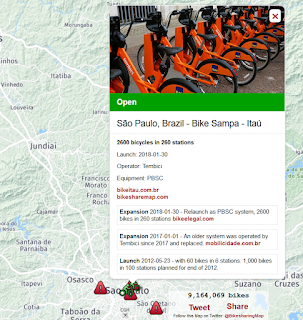We're delighted to present the first report of The Meddin Bike-sharing World Map -- a well-used reference tool by researchers, planners, professionals, and the general public -- which has been online since 2007. In this publication, entitled The Meddin Bike-sharing World Map - Mid-2021 Report, you'll read about The Meddin Map's history; on-going changes; perspectives for the future; and statistics, numbers, and stories of bike-sharing systems worldwide.
Bike-sharing has been a transformative tool for cities and populations, expanding access to services and opportunities, increasing mobility, and contributing to a more sustainable urban environment. At the writing of this report, many cities seem to be leaving the COVID-19 pandemic behind, reopening their activities, and implementing changes learned from this severe global event. Bike-sharing schemes survived the pandemic and proved to be resilient and flexible enough to inspire more profound changes in how we move around and experience our cities. By August 2021, there were more than 10 million bikes shared in diverse kinds of schemes.
This report comes along with improvements to The Bike-sharing World Map itself. With the passing of Russell Meddin, an 11-year veteran of The Bike-sharing World Map and The Bike-sharing Blog, in April 2020, the Map was relaunched by a team of bike-share enthusiasts from around the world to honor his memory and body of work he contributed to the field, and it was renamed The Meddin Bike-sharing World Map. Russell was a passionate bike-sharing pioneer based in Philadelphia (USA). For many years, he worked with me to provide accurate information about systems worldwide. Russell's dedicated work created a unique database of initiatives that by itself tells the history of this transportation system in our societies.
The Report includes an international team of curators and a sponsorship from PBSC Urban Solutions that made this report possible.
We hope you enjoy the reading!
Sincerely,
Paul DeMaio and The Meddin Bike-sharing World Map team of Thiago Benicchio, Steve Chou, Oliver O’Brien, Renata Rabello, and Chumin Yu












